Herb Roasted Chicken
Is there anything that typifies classic and comforting home-cooked dinners more than a whole roast chicken? You don’t have to answer that, we know the answer is no! Whether you are serving a roast chicken for Sunday Supper to family or you are meal-prepping chicken to have leftover chicken for the week ahead, having a back-pocket technique for perfectly juicy roast chicken is a must for any cook. This recipe will become yours, we guarantee it!

This post contains affiliate links.
Table of contents
Why You’ll Love This Herb Roasted Chicken
We have been perfecting our technique for juicy oven-roasted chicken, and today we have our tried and tested recipe to share with you here on Healthy Seasonal Recipes! Read on for our expert tips, step-by-step instructions, photos and video to help you every step of the way!
Our technique of cooking the chicken in a hot oven first (to brown the skin) then reducing the temperature and roasting the chicken low and slow creates a beautiful browned roast whole chicken with ultra-juicy chicken meat. You’ll need extra kitchen towels on hand when you carve this chicken, it is THAT juicy!
Roast Chicken Recipe Highlights
- Fresh herbs and garlic season the chicken and go with a wide variety of side dishes, but we have plenty of substitution ideas and ways to customize the seasoning.
- Makes 8 servings, so you can use this recipe for company or to have leftover cooked chicken for weeknight dinners. We have lots of ideas below for your leftovers.
- We included instructions for a simple pan sauce made with the drippings so you can drizzle it over your roast chicken and classic side dishes like buttermilk mashed potatoes.
- We have lots of side dish ideas below too to help you plan your menu
Equipment Notes
Like my Herb Roasted Turkey recipe, I wanted to give you a heads-up on the special equipment that you’ll need for this recipe before you get going. They are not required, but you’ll sure find them helpful!
- Roasting Pan and Rack: We use our all-clad chicken roasting pan to bake either baked chicken thighs or whole roasted chicken almost every week for about 8 months of the year and it is worth the investment. We have had our heavy roasting pan for 20 years and it is still in incredible shape! Look for one that comes with a removable rack. These roasting racks come in handy because they let the bottom of the chicken get more crispy. We also use our cast iron skillet to roast whole chicken too- so use that if you do not have a good heavy roasting pan.
- Kitchen Twine: Using butcher’s twine or kitchen string is not necessary, but helpful. You can buy kitchen twine in the kitchen section of the grocery store.
- Instant Read Thermometer: We strongly suggest buying an instant-read thermometer to ensure the chicken is cooked through, but not over-cooked. Many grocery stores will sell inexpensive metal versions or you can upgrade to a pro-level one like a thermapen.
Ingredient Notes For Herb Roast Chicken

Whole Chicken
Aim to buy a 4 1/2 pound to 5 1/2 pound chicken for this recipe. Of course, this technique works perfectly well with a larger or smaller chicken, it will only affect the timing! Just use your thermometer to check to see if it is done. More on that below!
We have tested this baked chicken recipe countless times and just like our roast turkey recipe, we got a wide range of timing due to the size and way that they are raised.
Essentially, if your chicken is a heritage chicken, pasture-raised or free range it may take a little longer to bake than a conventional chicken. To ensure that your roast chicken is perfectly cooked make sure that you check the internal temperature early if you have a conventional chicken and allow for a little extra time if you have an all-natural chicken.
For The Seasoning Paste
- Olive oil: This helps to make the herb mixture into a paste and also encourages browning. Feel free to use melted butter instead. I have also made this countless times without adding any extra fat and it will still work just fine!
- Garlic: We love the way the garlic tastes in the herb mixture. Finely chop two cloves of garlic to add to the mixture.
- Fresh Herbs: Make a blend of chopped rosemary, sage, oregano, parsley and/or thyme. For the cavity of the chicken, you’ll also want 2 whole sprigs each. Avoid using all rosemary as it is too strong in large amounts.
- Salt and Pepper: for seasoning. Note that we used coarse kosher salt, not regular table salt. Read more about subbing kosher salt in recipes here.
How To Roast a Whole Chicken

Step 1: Prepare Oven and Pan
Set oven rack in lower third of the oven. Preheat oven to 450 degrees F. Place roasting rack in roasting pan if using and coat the rack and pan with cooking spray.
Step 2: Prep Chicken
Place chicken on work surface and remove giblets. Loosen skin by running fingers between the skin and the breast meat.

Step 3: Make Herb and Garlic Paste
Stir oil, garlic, chopped herbs, salt and black pepper in a small bowl. Alternatively, you can brine your chicken, and season it only with the garlic, pepper and herbs (skip the salt in the seasoning rub.)
Step 4: Rub Herb Mixture on the Chicken
Rub garlic herb mixture between the skin and meat and in the cavity. Rub excess garlic and herb mixture onto the chicken breast and all over the outside of the chicken. Place herb sprigs inside the cavity of the chicken.

Step 5: Prep Chicken For The Oven
Tie the chicken legs together or truss with a preferred method with kitchen twine if desired. Place the chicken on the rack or directly on the surface of the roasting pan. Pour in 1 cup water around the chicken (or under the rack.)
Step 6: Roast The Chicken
Transfer the chicken to the oven and roast for 20 minutes. Without opening the oven reduce the heat to 325 and continue roasting until an instant-read digital thermometer registers at least 165 degrees when inserted into the deepest part of the thigh meat, 1 hour 20 minutes to 2 hours 10 minutes. Times will vary depending on the weight of the chicken and the thickness of the breast meat. A smaller four and a half lb chicken will be ready on the shorter end of the scale so check early and adjust your timing accordingly.
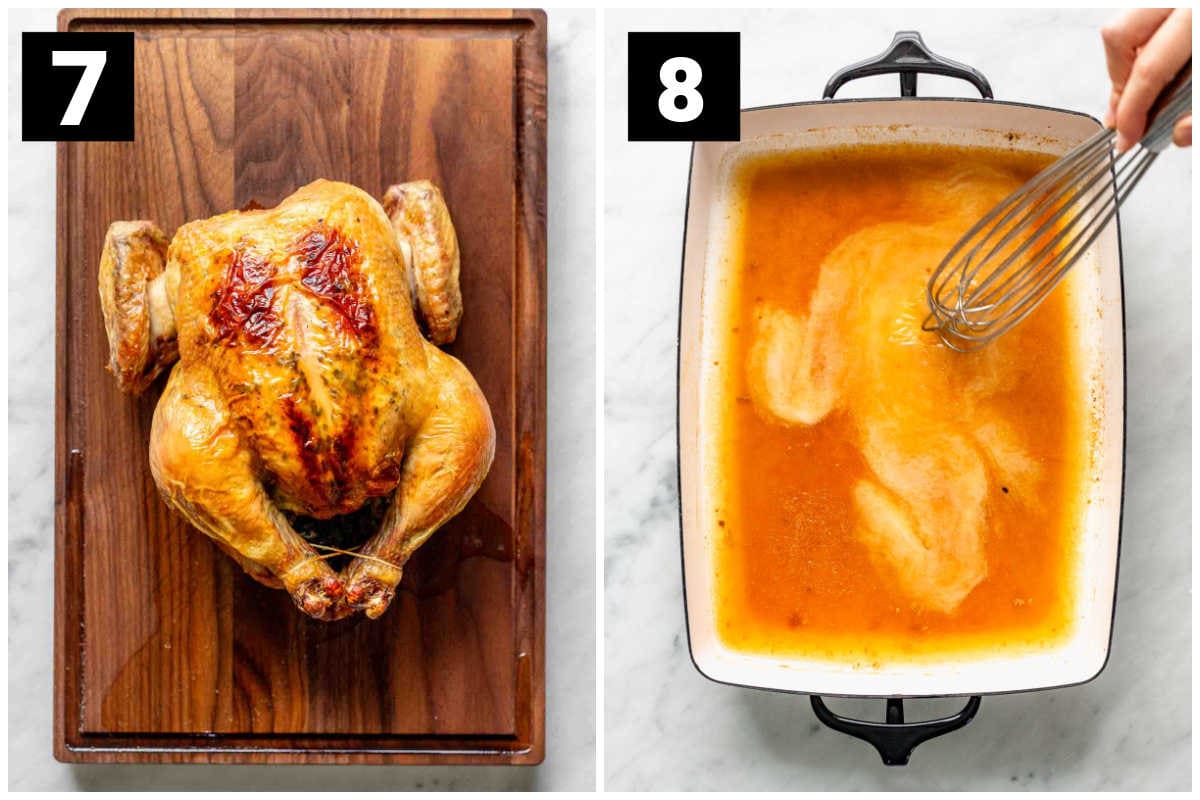
Step 7: Rest The Chicken Before Carving
Let the chicken rest for 20 minutes before carving. Place it on a carving board that has channels along the outer edge to catch the juices. It will be very juicy! If you want to let it rest longer, that is even better! Simply tent it with foil to keep it warm.
Step 8: Make the Pan Gravy
Remove the roasting rack. Pour about ¾ cup broth into the roasting pan with the pan juices and set on a burner over medium heat. Bring to a simmer, scraping up the pan drippings in bottom of the pan with a whisk. Stir cornstarch into the remaining ¼ cup broth. Whisk into the simmering broth, stirring constantly. Simmer, whisking until thick and shiny, about 3 minutes.

Step 9: How to Carve The Chicken
Carve the chicken: Remove the legs at the thigh joint. Cut into drumstick and thighs. Cut through the breast meat to the wishbone. Remove wings, leaving drummet attached if desired. Then cut along the sternum of the chicken and slide a knife along the rib bones to debone the chicken breast. Remove the chicken breast and set it on the cutting board. Slice into chunks. Save the carcass and bones for Homemade Chicken Broth.
Step 10: Serve Chicken with Gravy
Serve the chicken with the gravy.

FAQ and Expert Tips For The Best Oven Roasted Chicken
FAQs
What is the best oven temperature for roasting a whole chicken?
We recommend starting the oven at 450 degrees to crisp the skin, then reducing it to 325 degrees to slowly roast the chicken without drying it out.
Many of the restaurants I have cooked in have had some form of roasted chicken on the menu, and there are many ways to cook a chicken in the oven. I love the texture of a chicken that is roasted in a lower temperature oven. They come out tender like a Slow Cooker Whole Chicken or rotisserie chicken, and very juicy. A higher temperature oven is faster but it will yield firm chicken meat and the breast can seem dry.
How do you know when a baked chicken is safe to eat?
Use a thermometer to check that the chicken meat reaches a minimum of 165 degrees F.
What if the chicken skin gets too dark?
We have not had that problem with this chicken recipe because it is cooked at a lower temperature for a longer time, that said if the skin is getting too dark, tent the breast only with a shield of aluminum foil.
How long do you rest whole roasted chicken before carving?
You should rest the chicken for at least 20 minutes, but if time allows we suggest letting it rest even longer. To rest longer, place a couple of clean kitchen towels over the foil to help hold in the heat. Letting it rest will allow the juices to redistribute through the chicken breast and thighs so the meat will be very tender and juicy.
What is carryover cooking?
Whole roasted chicken, roasts and larger cuts of meat continue to cook even after they are out of the oven or off the heat. This phenomenon is known as “carryover heat.” Essentially the higher heat in the outer layers of the roast continues to move inward and increase the center temperature, coagulate the proteins, and kill any harmful pathogens.
Note that it is important to let the carryover heat continue to cook the chicken after you pull it from the oven so that a meat thermometer reaches a safe internal temperature of 165 degrees, without becoming dry or overcooked.
Can I stuff the chicken for roasting?
We do not recommend stuffing poultry or whole chicken for roasting. Our goal is to keep the chicken moist- so we do not want to overcook it. The problem with putting stuffing inside of the chicken is that the stuffing comes in direct contact with the raw chicken, so it has to be cooked to a safe temperature of 165 degrees F. But unfortunately, when it is stuffed inside the chicken it cannot get that hot inside without overcooking the breast meat. If you like to stuff your chicken (or turkey) then use a cloth stuffing bag. Once the chicken is done, pull out the stuffing bag and continue cooking the stuffing in a casserole dish until it is a safe temp. Try our cranberry sausage stuffing or our apple pecan nut cornbread stuffing.


Variations To Try
- Omit the garlic for a simple herb and seasoning blend.
- Use 1 1/2 teaspoons dried herbs such as Italian Seasoning or another purchased herb blend like Herbes de Provence instead of fresh herbs.
- Add lemon zest to the herb mix and lemon halves to the chicken cavity for lemon herb roast chicken.
- Roast garlic heads in the oven with your chicken and add the softened roasted garlic to the gravy for an umami boost of flavor.
- Skip the herb mix, and simply brush melted butter over the outside of the chicken breast and season with salt and pepper for a super simple but deliciously juicy chicken!
- Add a few pinches of chopped fresh thyme or fresh rosemary and whisk softened butter into the gravy to make it more luxurious.
What To Serve with Roasted Chicken



Below are some of our favorite side dishes to serve with roasted chicken.
- Cooked Carrots: We love cooked baby carrots, roasted baby carrots and maple glazed carrots for a classic side dish with baked chicken.
- Mashed Potatoes: Some favorites include Mashed Red Skin Potatoes and Roasted Garlic Mashed Potatoes or Creamy Low Carb Mashed Cauliflower for a lighter option.
- Green Beans: We love our green beans around here, and they are a classic side to pair with roast chicken. Our popular sauteed green bean recipe is a simple option or try green beans with balsamic and walnuts for a gourmet twist.
- Seasonal Vegetables: You can’t go wrong with seasonal veggie side dishes like Sauteed Swiss Chard, Steamed Brussels Sprouts or Succotash. Browse our side dish recipes here.
- Homemade Baked Goods: While your roasted chicken rests you can easily bake a batch of our healthy cornbread, corn muffins or maple pumpkin cornbread. Or serve this with our whole wheat rolls for a Sunday Supper with family. You can bake them in advance and then re-warm them before serving.
And if you are looking for more inspiration, we have more than a dozen ideas for what to serve with roasted chicken here.
What To Do With Leftover Chicken
Leftover chicken can be stored in an airtight container for up to three days. Freeze in a freezer ziplock bag for up to 2 months. (Make sure to press as much air out of the bag as possible before freezing.) You can use the leftover chicken meat in any recipe that calls for cooked chicken.
- Chicken salad: Try our Waldorf Chicken Salad, chopped salad with chicken or this simple Chimichurri Chicken Salad
- Casseroles: This Mexican Chicken Casserole is a simple family-friendly dish with Mexican-inspired seasonings, tortillas and extra veggies. Or try a healthy version of Ranch King Casserole sometime.
- Soup: Stir cooked chicken into Garden Vegetable Soup for added protein or use it for Chicken Quinoa Soup.
- Pizza: Add shredded leftover roasted chicken to your favorite pizza or try out Chicken Pesto Pizza.
- Burritos: Try our buffalo chicken burrito with the leftovers.
- Chicken Lettuce Wraps: Use in place of rotisserie chicken in Sesame Chicken Lettuce Wraps.
- Salad: Add on top of a classic Caesar Salad or top Massaged Kale Apple Salad with it.
More Family-Friendly Chicken Recipes
Thanks so much for reading! If you are new here, you may want to sign up for my email newsletter to get a free weekly menu plan and the latest recipes right to your inbox. If you make this recipe, please come back and leave a star rating and review. I would love to hear what you thought!
Happy Cooking! ~Katie
Print
Herb Roast Chicken Recipe
- Total Time: 2 hours 10 minutes
- Yield: 8 servings 1x
Description
This classic recipe for Garlic Herb Roasted Chicken is juicy, tender and succulent! It is enough for a meal for four plus enough leftovers to make another dinner. Or serve a small crowd for Sunday Supper.
Ingredients
- 4 1/2 to 5 1/2 pound whole chicken, giblets removed, dried with paper towels
- 1 tablespoon olive oil
- 2 cloves chopped garlic
- 1 tablespoon mixed chopped rosemary, sage, oregano, parsley and/or thyme
- plus 2 whole sprigs each
- 1 1/4 teaspoon coarse kosher salt
- Freshly ground pepper to taste
- 1 cup chicken broth, divided
- 1 teaspoon cornstarch
Instructions
- Set oven rack in lower third of the oven. Preheat oven to 450 degrees F. Place roasting rack in roasting pan if using and coat the rack and pan with cooking spray.
- Place chicken on work surface and remove giblets. Loosen skin by running fingers between the skin and the breast meat.
- Stir oil, garlic, chopped herbs, salt and pepper in a small bowl.
- Rub garlic herb mixture between the skin and meat, in the cavity and all over the outside of the chicken. Place herb sprigs inside the cavity of the chicken.
- Tie the chicken legs together or truss with preferred method with kitchen twine if desired. Place the chicken on the rack or directly on the surface of the roasting pan. Pour in 1 cup water around the chicken (or under the rack.)
- Transfer the chicken to the oven and roast for 20 minutes. Without opening the oven reduce the heat to 325 and continue roasting until an instant-read digital thermometer registers at least 165 degrees when inserted into the deepest part of the thigh meat, 1 hour 20 minutes to 2 hours 10 minutes. Times will vary depending on the weight of the chicken and thickness of the breast meat.
- Let the chicken rest for 20 minutes before carving.
- Remove the roasting rack. Pour about ¾ cup broth into the roasting pan and set on a burner over medium heat. Bring to a simmer, scraping up the bottom of the pan with a whisk. Stir cornstarch into the remaining ¼ cup broth. Whisk into the simmering broth, stirring constantly. Simmer, whisking until thick and shiny, about 3 minutes.
- Carve the chicken: Remove the legs at the thigh joint. Cut into drumstick and thighs. Cut through the breast meat to the wishbone. Remove wings, leaving drummet attached if desired. Then cut along the sternum of the chicken and slide knife along the rib bones to debone the chicken breast. Remove the chicken breast and set it on the cutting board. Slice into chunks.
Notes
Leftovers
Leftover chicken can be stored in an airtight container for up to three days. Freeze in a freezer ziplock bag for up to 2 months. (Make sure to press as much air out of the bag as possible before freezing.) You can use the leftover chicken meat in any recipe that calls for cooked chicken.
- Prep Time: 20 minutes
- Cook Time: 2 hours
- Category: Main Course
- Method: Oven
- Cuisine: American
Nutrition
- Serving Size: 4 ounces
- Calories: 213
- Fat: 11 g
- Carbohydrates: 1 g
- Fiber: 0 g
- Protein: 25 g




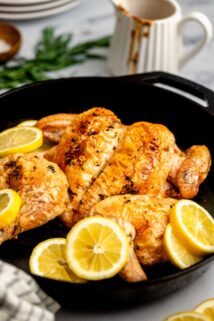
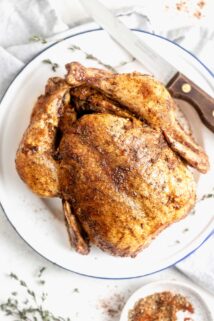
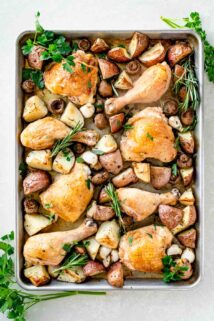
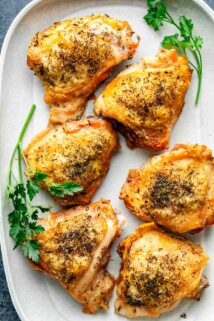
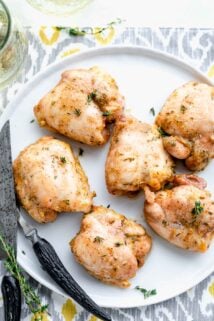
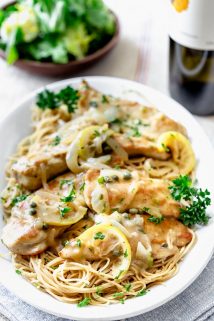
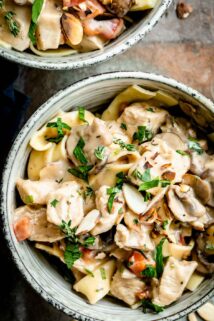
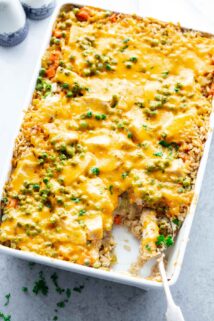
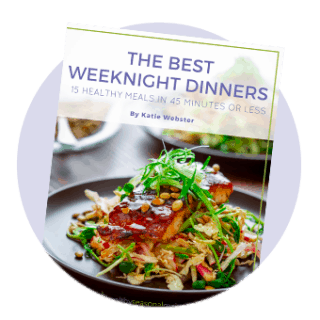

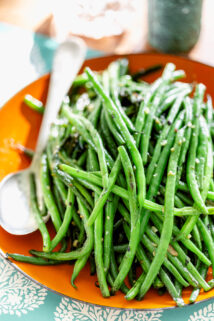
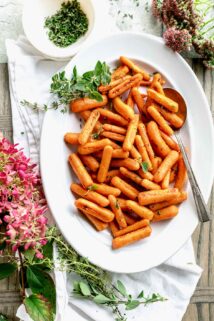
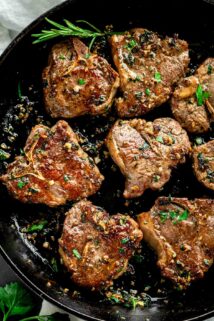
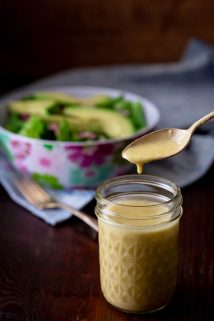
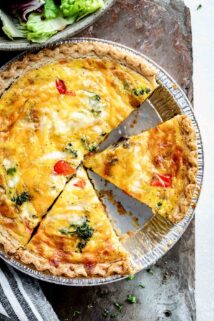
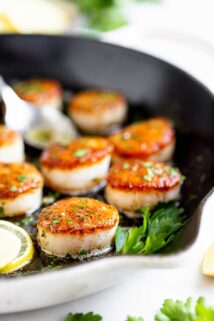
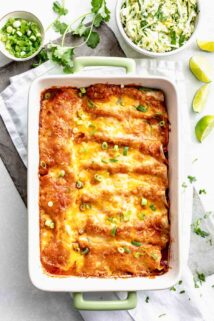
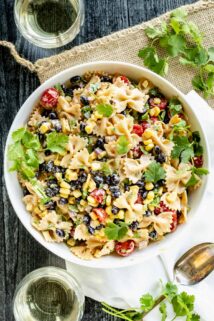

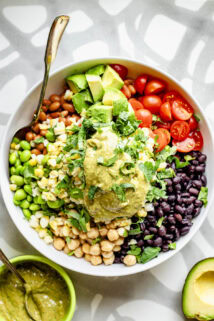
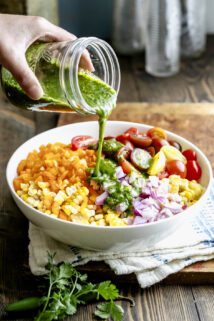
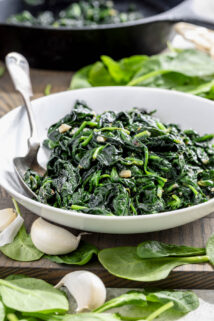
The chicken came out great. It was difficult getting under the skin, but I did the best I could. It was so tasty and moist I didn’t need to use gravy.
Thanks for reporting back Neil. Getting the herbs under the skin isn’t super easy and takes a little practice. Next time, you can use a spoon to scoot it in further if your fingers won’t reach.
Really nice recipe. There not much more lovely than a beautiful roast chicken.
I totally agree- it’s home cooked comfort food at its best. Thank you so much for coming by.